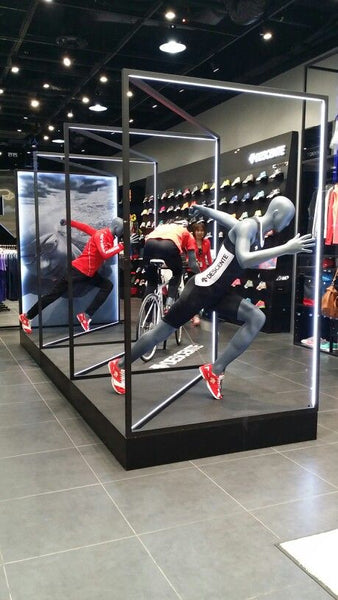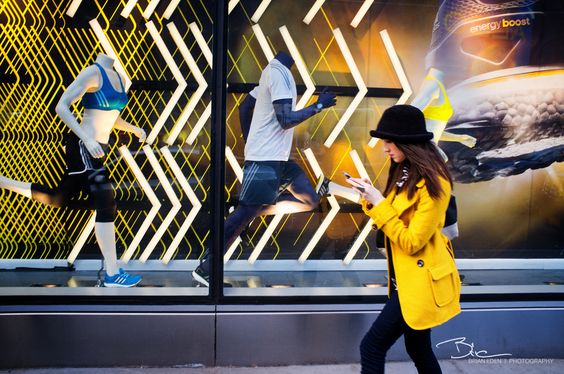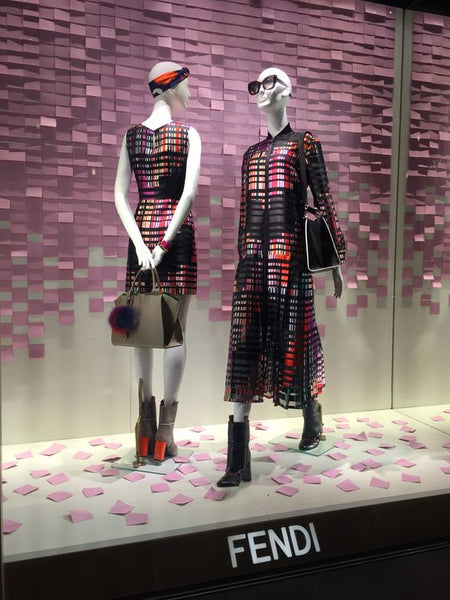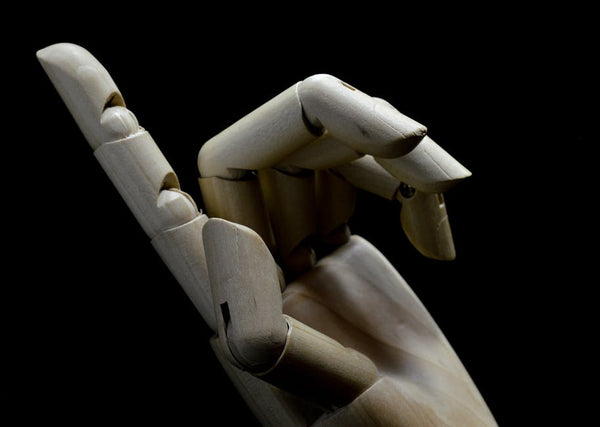In an era where brick-and-mortar stores serve as the physical touchpoint between a brand and the consumer, retailers need to excite customers as much as possible. And it starts by drawing them in with a high-impact window display.
A store’s visual presentation not only tells a brand story, it also piques imagination and curiosity, and conjures up emotional feelings of “I need to have this!” — which is truly the ultimate goal.
Kathlin Argiro is a New York-based dress designer at Kathlin Argiro Design Studio and a professor at Parsons School of Design. Take it from her: “The number one thing customers are looking for in retail is an experience. It’s not just about the product(s) they are buying. They also want to feel that they’re in a special environment where they get individual attention. That’s why there has been an upswing for smaller designer retail boutiques and a major downturn in business for the big-box retailers.”
We consulted a panel of experts, including retailer owners and merchandising professors, to learn more about how to ensure your merchandising is on-point — and on track to increase sales.
Product Display and Visual Merchandising Rules
1. Know Your Customer
As obvious as this sounds, it bears repeating: knowing what your customer wants is a critical step in merchandising and merchandise planning.
Fashion tech entrepreneur and strategy and product development consultant Chaya Cooper, founder of Click2Fit, says that when it comes to displaying your products and knowing what to add to your product assortment in the first place, understanding your customers’ needs is of prime importance. So, if something isn’t selling well, yes it can be a matter of determining whether it has hanger appeal or needs to be better showcased, but it’s also a matter of asking yourself: “Did I make a mistake by purchasing this? Does my customer actually want this?” (More on this, below.)
2. Show What You’re Selling
Kirsten La Greca, founder of Rosa Gold, previously worked in visual presentation at two major fashion retail flagship locations (one of which was at The Grove in Los Angeles). According to La Greca, “Most customers buy what they see. Simple as that.” she said.
They want the look that's in the window or on the mannequin. Stores can become overwhelming, so putting together products for them can help in the decision-making process.
She noted that this concept isn’t exclusive to brick and mortar stores, either. “This translates online too. Customers will want exactly what's featured in the picture, so if you're a fashion retailer, displaying tops that you sell with certain bottoms not only makes it easy for them to make a purchasing decision, but might push them to buy the whole outfit.”
3. Know The Tools Of The Trade
Full Mannequins
Fashion designer and professor Kathlin Argiro gave us the full scoop on mannequins as display tools.
“Mannequins are always some version of the human body including arms, legs, etc. The look of mannequins widely varies: they can go from having a very realistic look to being very abstract and artistic.”
We also spoke with Dimitri Koumbis, co-founder of the ecommerce platform Bishop Collective (which offers American manufactured goods that eloquently combine fashion, art, and lifestyle) and part-time lecturer at Parsons and Rutgers Business School.
Koumbis explains: “Mannequins are made to mimic the details of the human body, and can be very highly stylized. Depending on the retailer, they may choose a mannequin type that speaks to their customer base through gender, size, shape and/or materiality. Most retailers will purchase mannequins that not only relate to their customer base, but also those that will best display their product. As well, mannequins are a bit more delicate than body forms and should be handled with care as to not chip, scuff or break.”
Dress Forms and Body Forms
So, how do dress and body forms differ?
Dress forms are used in the fashion industry as a technical tool to drape and make patterns. Argiro clarifies further: “They serve as a general ‘template’ for the human body but are not anatomically ‘correct’ like traditional mannequins are.”
It’s important to note that a dress form’s main function is to be used in the creative process for fashion design.
Once you understand this, we dive deeper into the difference between dress forms and body forms, which are not synonymous.
Koumbis continues: “Many retailers use the terms ‘dress form’ and ‘body form’ interchangeably, but a dress form is typically heavier and has thicker padding and collapsible shoulders, to aid in dressing the form. Fashion design professionals typically use dress forms, whereas a retailer will use a body form, which resembles a dress form, but is much lighter, has less padding, and can come in a plethora of material options. They are also much less expensive. Although a body form, like a dress form, has no head or limbs, body forms are used for the sole purpose of displaying merchandise.”
Which One To Use? Mannequins vs. Body Forms
Mannequins are more specific, less timeless: According to Argiro, “Mannequins are much more specific and should represent the designer's target customer. Traditional dress and body forms are more generic so they provide a flexibility and timelessness that cannot be captured with a mannequin. Just like fashion trends, mannequins go in and out of style so your investment generally has a ‘shelf life’ if you want to stay current with the look of your displays. For this reason, I recommend dress or body forms for smaller designers so that this becomes a non-issue. The timeless quality of a dress form — i.e. they never go out of style — is also a big plus for maximizing your investment.”
Dress and body forms double as a tool for designers: Argiro continues: “The additional advantage of using a dress form is that it can also double as a practical tool in a designer's atelier, in addition to serving as a prop for display.”
So, for designers who have a limited budget, this could be a smart and practical choice.
Anthropologie and Free People (both part of the same parent company, URBN brands), boasts best-in-class window and in-store displays, usually featuring body and dress forms.
 Image: Pinterest
Image: Pinterest

Image: Pinterest
Consider what you’re selling: Some products are meant to be showcased on mannequins, such as athletic wear (i.e. yoga, exercise and running gear). Argiro explains: “There’s much more of an impact when these are displayed on mannequins, which capture the dynamic nature of the sport or activity.”
This is a noticeable trend in store displays at retailers such as lululemon, where the mannequins are often in various yoga poses. Argiro continues: “The use of specific mannequins makes it very easy for the customer to envision wearing the clothes themselves.”
Koumbis adds that Nike stores often use athletic body mannequins in motion for this reason.
 Image: Pinterest
Image: Pinterest

Image: Pinterest
Again, know your customer: Argiro’s advice is to carefully consider who your customer is and how they will best relate to your product when it’s visually displayed.
Unsure? Do some reconnaissance work and check out what your top competitors are doing, as established apparel companies will have collected a vast amount of data to make the best choice to convert displays into sales. Argiro adds: “Once you determine this, you have to determine your budget and make an appropriate choice.”
Designer brands and higher-end department stores tend to have interesting examples of creative store windows, so explore those stores IRL or do a Pinterest search for “store displays,” “store windows” or “mannequin inspiration.” A walk down 5th Avenue in New York City can give you tons of inspiration alone! If you have a travel budget, try to make time to explore the high-fashion streets of different cities and snap pics, especially if you’re on buying trips.

Image: Pinterest
TAKEAWAY: “Choosing between a mannequin and a body form depends on the retailer’s needs and overall brand aesthetic, but it’s important that retailers be consistent in their displays in order to best present a cohesive message. While mixing mannequin types and/or body forms is not forbidden, it often comes across as amateur and messy. For example, department stores will implement a variety of both mannequins and body forms, but they are often department/brand specific and not often intermixed.” —Dimitri Koumbis, co-founder of Bishop Collective and part-time lecturer at Parsons and Rutgers Business School.
Consider your budget: Koumbis explains: “While both body forms and mannequins can be costly to purchase, mannequins can easily exceed budgeted costs due to the variety of options (style and materiality) available to retailers.”
Where To Find Mannequins & Dress/Body Forms
 As is usually the case, there’s a high to low range of suppliers for mannequins, body forms and dress forms.
As is usually the case, there’s a high to low range of suppliers for mannequins, body forms and dress forms.
You can find mannequins ranging from the super high-end, avant-garde and artistic (Ralph Pucci Mannequins, Genesis Mannequins and Manex USA) to the more commercial (Mannequin Mall, StoreSupply.com and Mannequin Madness, all of which sell mannequins and body/dress forms). Garment fitting forms can also be on the high-end scale, such as those found at Wolf Form Company and Superior Model Form Co.
The cost range of mannequins is also broad, starting from approximately $200 to upwards of $1,000 (depending on the mannequin’s material and design; many of the higher-end vendors don’t publish prices in their online catalogs, so you would need to inquire directly).
The cost of forms can be even broader, as it depends on what “parts” you need: a simple bust (which can cost in the $60 to $100 range) versus the full body form (which can range from $200 to upwards of $600).
Show and Tell: Make Retail Magic
As you can see, there are many fashion display tools to help make your storefront, interior display and actual merchandise stand out. So think outside the box, keep your eyes open for inspiration, and assess which type of display tool works best for your apparel and target customer.
By knowing your customer well (note: ask for feedback and ask the right questions!) and translating this knowledge into purchasing and display decisions, you will strike retail gold.
Read more
- What Retailers Can Learn From These 5 Examples of Experimental Store Formats
- Let There Be Light: Retail Lighting Designs to Encourage Sales
- 12 Retail Window Displays that Drive Sales
- How To Hire an Interior Designer for Your Retail Store (And Why You Need One)
- Slow Shopping: Why Retailers Should Focus on Discoverability In-Store
- Why Your Store Needs a Size Chart (And How to Create One)
- Product Merchandising: 11 Ideas to Steal (+3 Examples)
- 10 Visual Merchandising Tips for Increasing Event Sales
Displaying Your Merchandise FAQ
What is the best way to display mannequins?
What are the 5 R's of merchandising?
- Research: Analyze customer data, industry trends, and competitor activity to identify opportunities and create strategies.
- Range: Select the right mix of merchandise to meet customer needs and wants.
- Refine: Refine the assortment to ensure it is up to date and relevant.
- Review: Monitor sales, customer feedback, and stock levels to ensure the assortment is performing.
- Refresh: Regularly update and refresh the assortment to keep it fresh and appealing to customers.
What are the different types of mannequins?
- Abstract Mannequins: These mannequins feature abstracted limbs and facial features and lack realistic details.
- Abstract Plus Mannequins: These mannequins are more realistic than abstract mannequins, featuring abstracted but realistic arms, legs, and facial features.
- Realistic Mannequins: These mannequins feature realistic arms, legs, and facial features and are designed to look like real people.
- Plus-Size Mannequins: These mannequins are designed to represent plus-size individuals.
- Flexible Mannequins: These mannequins are designed to be adjustable in order to fit a variety of clothing sizes.
- Dressmaker’s Mannequins: These mannequins are designed to be used by tailors and dressmakers when creating clothing.
- Animated Mannequins: These mannequins are designed to move and are used in window displays.
- Children’s Mannequins: These mannequins are designed to represent children of various ages and sizes.
How do you showcase merchandise?
- Create attractive displays
- Utilise appropriate lighting
- Use vibrant colors and visual cues
- Feature merchandise in cross-selling displays
- Offer discounts and promotions
- Place items close to point of purchase
- Incorporate props to add context
- Organize items according to category
- Offer samples for customers to try
- Incorporate digital displays





